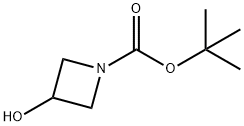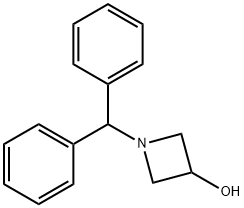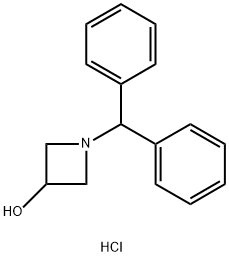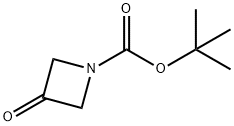
1-N-Boc-3-hydroxyazetidine synthesis
- Product Name:1-N-Boc-3-hydroxyazetidine
- CAS Number:141699-55-0
- Molecular formula:C8H15NO3
- Molecular Weight:173.21

18621-17-5

24424-99-5

141699-55-0
General procedure for the synthesis of N-Boc-3-hydroxyazetidine from 1-diphenylmethyl-3-hydroxyazetidine and di-tert-butyl dicarbonate: (1) Dissolve 1-diphenylmethyl-3-hydroxyazetidine (10.0 g, 41.8 mmol) in methanol (300 ml), add 10% palladium-carbon catalyst (10.0 g), and carry out the catalytic hydrogenation reaction at room temperature for 3 hours. After completion of the reaction, the catalyst was removed by filtration. To the filtrate was added di-tert-butyl dicarbonate (18.2 g, 83.6 mmol) and stirred at room temperature for 1 hour. After completion of the reaction, the reaction mixture was concentrated under reduced pressure. The residue was purified by silica gel column chromatography with the eluent being hexane: ethyl acetate (1:1→1:2) to afford 1-tert-butoxycarbonyl-3-hydroxyazetidine (7.05 g, 97% yield). (2) To a solution of 1-tert-butoxycarbonyl-3-hydroxyazetidine (2.5 g, 14.4 mmol) in dimethylformamide (125 ml) was added sodium hydride (55% oil dispersion) under ice bath conditions. The ice bath was stirred for 10 minutes followed by 30 minutes at room temperature. Subsequently, iodomethane (1.79 ml, 28.8 mmol) was added to the ice bath and the ice bath was stirred for 10 minutes followed by 1 hour at room temperature. After completion of the reaction, 10% aqueous acetic acid solution was added to the ice bath and stirred for 30 minutes. The reaction mixture was partitioned between ethyl acetate and 10% aqueous sodium chloride solution. The organic layer was washed sequentially with saturated aqueous sodium bicarbonate solution and saturated aqueous sodium chloride solution, dried over anhydrous sodium sulfate, filtered and concentrated under reduced pressure. The residue was purified by silica gel column chromatography with hexane:ethyl acetate (2:1) as eluent to afford 1-tert-butoxycarbonyl-3-methoxyazetidine (2.18 g, 81% yield) as a colorless oil.1H-NMR (400 MHz, CDCl3): δ (ppm) 4.16-4.10 (1H, m), 4.09-4.03 (2H, m ), 3.82 (2H, dd, J = 10.2,4.4Hz), 3.28 (3H, s), 1.44 (9H, s).

24424-99-5
868 suppliers
$13.50/25G

90604-02-7
228 suppliers
$7.00/10g

141699-55-0
392 suppliers
$6.00/1g
Yield:141699-55-0 357 g
Reaction Conditions:
Stage #1: 1-(diphenylmethyl)-3-azetidinol hydrochloridewith sodium carbonate in dichloromethane;water at 20;
Stage #2: di-tert-butyl dicarbonatewith palladium on carbon;hydrogen in tetrahydrofuran at 20; under 1551.49 Torr; for 18 h;
Steps:
2.2 Step 2. tert-Butyl 3-hydroxyazetidine-l -carboxylate (10)
Step 2. tert-Butyl 3-hydroxyazetidine-l -carboxylate (10) A suspension of l-benzhydrylazetidin-3-ol hydrochloride (9, 625 g, 2.27 mol) in a 10 % solution of aqueous sodium carbonate (Na2C03, 5 L) and dichloromethane (CH2CI2, 5 L) was stirred at room temperature until all solids were dissolved. The two layers were separated, and the aqueous layer was extracted with dichloromethane (CH2CI2, 2 L). The combined organics extracts were dried over sodium sulfate (Na2SC>4) and concentrated under reduced pressure. This resulting crude free base of 9 was then dissolved in THF (6 L) and the solution was placed into a large Parr bomb. Di-teri-butyl dicarbonate (BOC20, 545 g, 2.5 mol, 1.1 equiv) and 20 % palladium (Pd) on carbon (125 g, 50 % wet) were added to the Parr bomb. The vessel was charged to 30 psi with hydrogen gas () and stirred under steady hydrogen atmosphere (vessel was recharged three times to maintain the pressure at 30 psi) at room temperature for 18 h. When HPLC showed that the reaction was complete (when no more hydrogen was taken up), the reaction mixture was filtered through a Celite pad and the Celite pad was washed with THF (4 L). The filtrates were concentrated under reduced pressure to remove the solvent and the residue was loaded onto a Biotage 150 column with a minimum amount of dichloromethane (CH2CI2). The column was eluted with 20 - 50 % ethyl acetate in heptane and the fractions containing the pure desired product (10) were collected and combined. The solvents were removed under reduced pressure to afford terr-butyl 3-hydroxyazetidine-l - carboxylate (10, 357 g, 393.2 g theoretical, 90.8% yield) as colorless oil, which solidified upon standing at room temperature in vacuum. For 10: 'iTNMR (CDCI3, 300 MHz), δ 4.56 (m 1 H), 4.13 (m, 2H), 3.81 (m, 2H), 1.43 (s, 9H) ppm.
References:
WO2013/36611,2013,A1 Location in patent:Page/Page column 27

18621-17-5
387 suppliers
$5.00/1g

24424-99-5
868 suppliers
$13.50/25G

141699-55-0
392 suppliers
$6.00/1g

24424-99-5
868 suppliers
$13.50/25G

18621-18-6
471 suppliers
$8.00/5g

141699-55-0
392 suppliers
$6.00/1g

398489-26-4
441 suppliers
$9.00/5g

141699-55-0
392 suppliers
$6.00/1g

45347-82-8
141 suppliers
$45.00/50mg

24424-99-5
868 suppliers
$13.50/25G

141699-55-0
392 suppliers
$6.00/1g